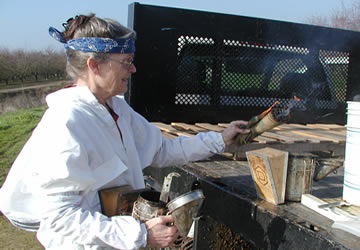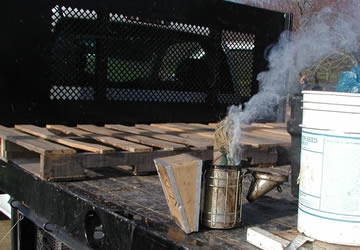|
For the bees, the
trip to California by truck is planned so they arrive just as the sun
goes down, get unloaded and spread out through the orchards that night;
placing them in groups - usually 6 pallets or 24 hives per drop. After
placement, they are left undisturbed to "settle in" for several
days, during which time they get acclimated to the area and begin flying
- something they haven't been able to do for the past months in while
storage in Idaho. After this little respite, the work of inspecting each
hive for health and strength begins. When the almond bloom occurs, there
must be a sufficient field force of bees to complete the pollination during
the short time the flowers are open. Hive population is checked for strength
and hive strength is measured by the number of frames in the hive covered
with bees. Ultimately, it is the number of bees, not the number of hives,
that make it possible to pollinate the crop during the short time interval
of the bloom. Those hives not meeting the minimum frame count requirement
are removed and not rented. The hive must not only have the necessary
frames of bees, but it must also be queen-right (have a viable queenbee)
to ensure an on going bee population in the hive.
The hive inspection
process begins using a hive tool to open and remove the lid followed by
a few puffs of smoke to calm the bees. Frames are then removed from the
hive as necessary for checking (above). The hive tool in the picture is
two tools in one with a "hooked" end for lifting frames, while
the other end (shown on the next page) is for prying and separating boxes
or lids. The smoker is a great help in calming the bees during the process.
In addition to the calming effect, the smoke triggers their naturally
programed reactive instinct to survive in the presence of fire. That is
to return immediately to their combs to fill up on honey prior to taking
flight when the fire arrives, as would be the case when a forest fire
occurs.
|



